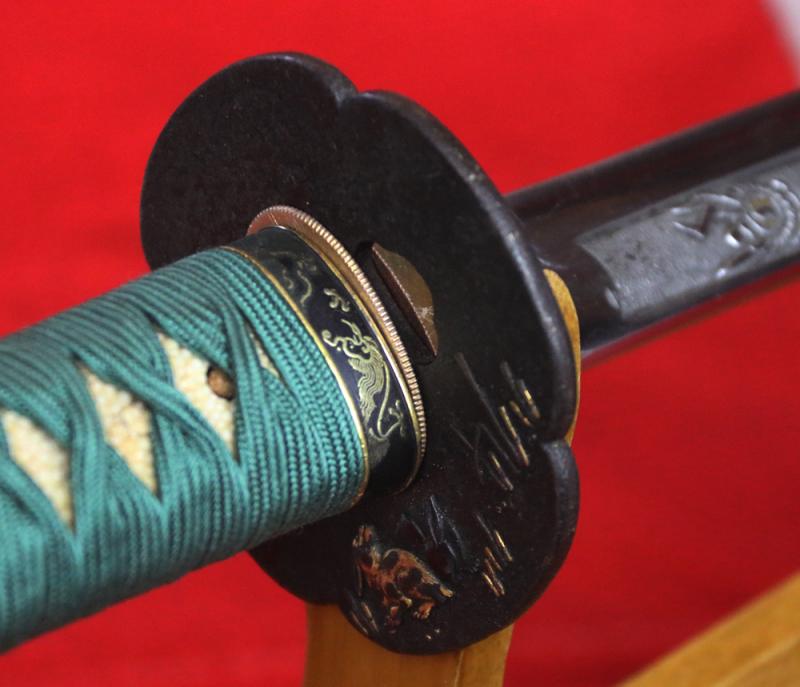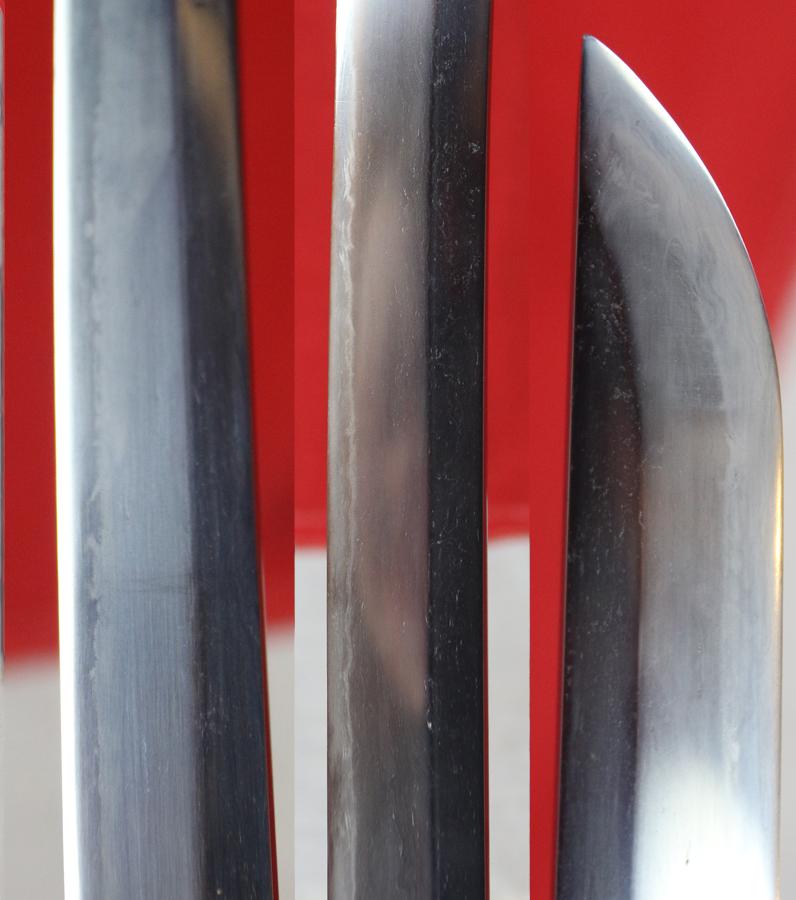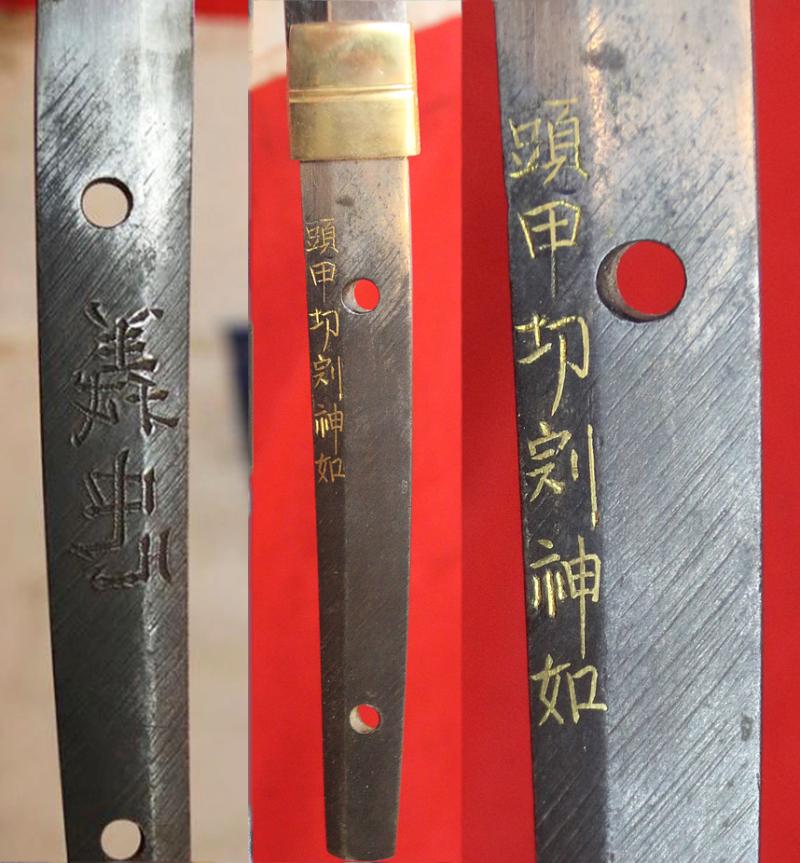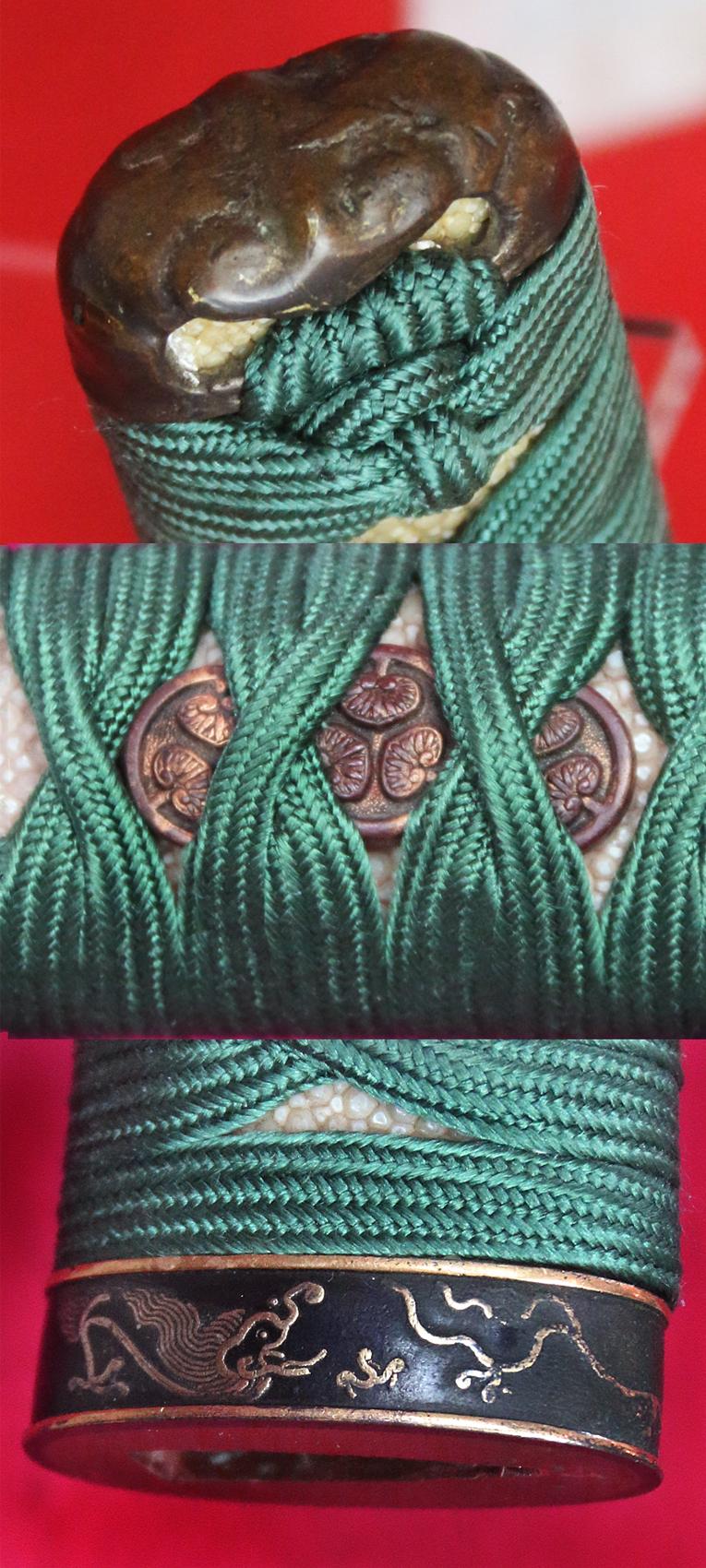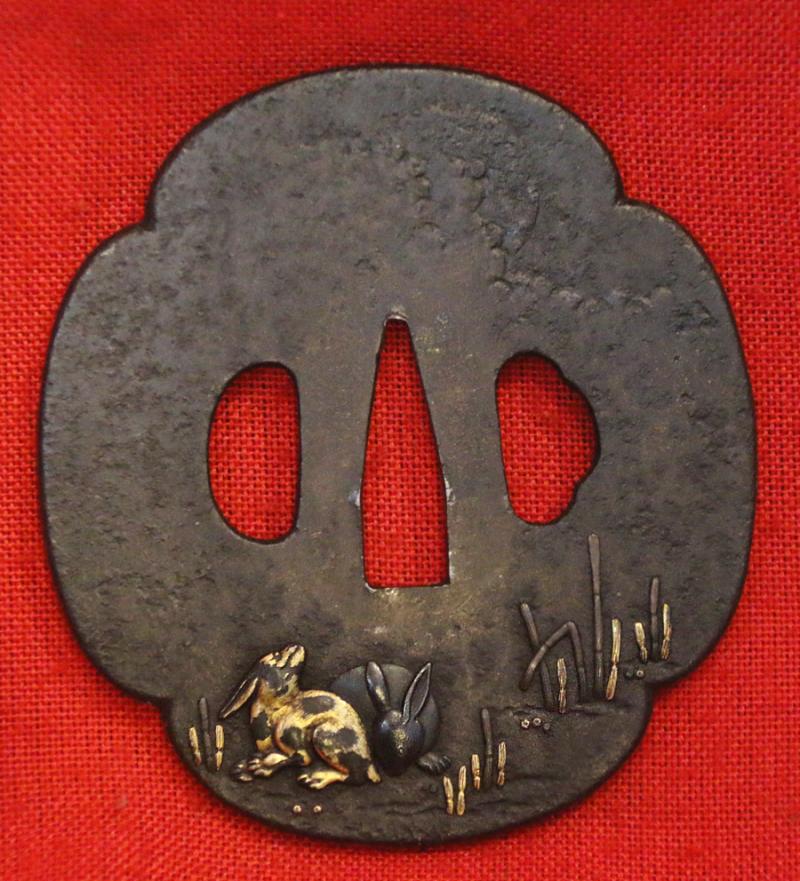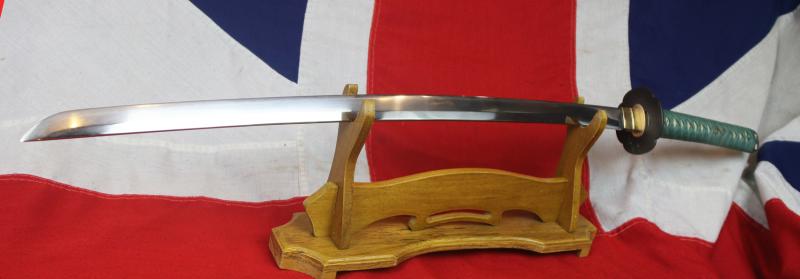350 Year Old Tengu Yokai Horimono Katana Signed Yoshitada. It is Titled in Gold "The Sharpness That Chops Up the Skull Like a God" One of The Most Intriguing Katanas We Have Seen, With Inlaid Gold Attribution of Its Cutting Ability, & the Blade’s Title
Now re-photographed and re-entered and priced on our site as the blade has just returned from artisan cleaning. A very special offer sword
This magnificent, mystical, original samurai sword bears the engraving "The Sharpness That Chops Up the Skull Like a God" to one side of the tang, and it is signed by Yoshitada, separately on the other side of the blades nakago. It’s inscription is chiseled into the blade's tang, then inlaid with gold, it is either a declaration of its incredible sharpness by attribution, a kind of Tameshigiri body cutting test but certainly not a more usual cutting test or, more likely, it is the name or title that was actually given to the sword. Either possibility of its meaning is very rare, although we have seen two swords that were graced with a name title before. A National Treasure historismus blade we owned, known as the Kusanagi-no-Tsurugi "Grass-Cutting Sword" one of the Imperial Japanese national treasures, and another blade, that was formerly owned by a great friend of ours, the author and renown expert on bayonets and fighting knives, Gordon Hughes. His sword was chiselled on the nakago, and then also inlaid and titled in gold like our sword, 'Dew on the Grass'.
The hilt of this amazing sword has just been re-wrapped by us in the same, stunning, traditional Japanese green silk tsuka-ito, just as its former old Edo tsuka ito was, but that was badly frayed and had to be replaced. The blade’s surface has just been very lightly and expertly cleaned by us to remove some dried preservative oil grime, and light cosmetic surface marks, and it has revealed a beautiful and active hamon, based on suguha straight
It now looks absolutely stunning, and it is an incredibly rare beauty. A ‘statement piece’ for any collection of fine art, or, a stunning decor piece for a private home, or such as 'Forbes 500' executive’s boardroom. This is now a long retired former samurai's weapon of wonder, that could naturally never be used again for the purpose for which it was made in hand to hand combat, nor should it be, but simply to be admired with awe for its elegance and its unique and incredibly rare holistic beauty and most rarest of features, probably never, ever, before combined in a samurai sword.
A few years ago, as we previously mentioned, we had the incredible honour to own albeit briefly a sword made by Imperial Japanese edict, in the 19th century, as a recreation of a sword that was a Japanese National Treasure, called Kusanagi-no-Tsurugi, which translates to "Grass-Cutting Sword". Victor Harris of the British Museum world renown expert of Japanese swords and their history, confirmed the history of our blade for us, and detailed its rarity as an 'official' copy of the original Japanese National Treasure, a sword that even the emperor is apparently not allowed to see, but used at his enthronement, covered underneath a silken cloth, by which way he is able to handle it without it being exposed.
Not only is our beautiful sword inlaid with gold, with its name or title, it is also signed, Yoshitada, and was made in around 1675.
The Smith’s reference; Yamato Washu ju Yoshitada is in W.M. Hawley’s classification of Swordsmiths, number Yos1691.
It has a most incredible ‘Yokai’ subject carved horimono on the blade, the type of which we have not seen in the past 40 years or more. It is a Crow-Tengu, and the signed tang has a pure gold inlaid attribution on the opposite side of the nakago, that translates to; "The Sharpness That Chops Up the Skull Like a God"
The Edo tsuba is a mokko form tetsu plate, with gold overlaid takebori kamibashi moon rabbits in grasses under a moonlit sky. The tsuka has a fine fuchi of iron with pure gold rims and inlaid with stylised gold dragon. The kashira appears to be a double sided, stylised, demon’s open mouth below a nose form. The pair of menuki under the tsuka-ito are Tokugawa triple aoi leaf mon in gilt sinchu. The blade has a nice clear hamon, it is both beautiful and bright, with next to no signs at all of old corrosion, yet the sword has clearly been used in combat hence its remarkable combat ability as illustrated in the fine gold inscribed name that it bears and thus it has old traces of battle impact, likely made centuries ago, at the bottom edge section, but the traces of such combat stress marks are fortunately almost invisible to the naked eye.
We recall we had a blade with a similar tengu horimono about 50 years ago, possibly carved by the same artisan, but we have never seen another, anywhere since. What this blade lacks in perfection, due to its samurai combat use over the centuries, the sword more than makes up for it in its simply amazing holistic beauty and the incredible rarity of its features. There is likely no other samurai sword ever been made like this sword ever before, or since.
There is another incredibly interesting feature about this sword, it has aspects of four completely spiritual entities, including, the Yokai tengu, the dragon, the demon, and the moon rabbit, all represented and depicted in differing ways upon the sword, with the crow-tengu as the dominant entity.
In Japanese folklore, one of the most intriguing *yokai is the Tengu. Considered by some to be a type of demon, and by others as a demi-god, the tengu can be found throughout the folklore and art of Japan.
The karasu tengu they are known for their martial arts skills and will train warriors, as depicted in many of the ukiyo-e prints. They are able to communicate without speaking, having powers of telepathy. They are known to shape-shift and can create strong winds by beating their wings or by using the featured fans they are often depicted with.
The young warrior Ushiwakamaru, later known as Minamoto no Yoshitsune, was sent to Mount Kurama as a boy by his mother’s cruel lover, Taira no Kiyomori. There he learned the secrets of martial arts from the tengu, strange creatures who lived there under the sway of their king, Sojobo. Ushiwakamaru became skilled at fighting. Here in the gallery is a woodblock print, of combat with tengu in the forest, and another of a tengu menpo, and an Edo tengu figure in carved wood.
Some of the earliest representations of tengu appear in Japanese picture scrolls, such as the Tenguzōshi Emaki (天狗草子絵巻), painted c. 1296, which parodies high-ranking priests by endowing them the hawk-like beaks of tengu demons.
Tengu is often pictured as taking the shape of some sort of priest. Beginning in the 13th century, tengu came to be associated in particular with yamabushi, the mountain ascetics who practice Shugendō. The association soon found its way into Japanese art, where tengu are most frequently depicted in the yamabushi's unique costume, which includes a distinctive headwear called the tokin and a pompom sash (結袈裟, yuigesa). Due to their priestly aesthetic, they are often shown wielding the khakkhara, a distinct staff used by Buddhist monks, called a shakujō in Japanese.
Tengu is commonly depicted holding a magical feather fan (羽団扇, hauchiwa). In folk tales, these fans sometimes can grow or shrink a person's nose, but usually, they have attributed the power to stir up great winds. Various other strange accessories may be associated with tengu, such as a type of tall, one-toothed geta sandal often called tengu-geta.
The Konjaku Monogatarishū, a collection of stories published in the late Heian period, contains some of the earliest tales of tengu, already characterised as they would be for centuries to come. These tengu are the troublesome opponents of Buddhism, who mislead the pious with false images of the Buddha, carry off monks and drop them in remote places, possess women in an attempt to seduce holy men, rob temples, and endow those who worship them with unholy power. They often disguise themselves as priests or nuns, but their true form seems to be that of a kite.
Throughout the 12th and 13th centuries, accounts continued of tengu attempting to cause trouble in the world. They were now established as the ghosts of angry, vain, or heretical priests who had fallen on the "tengu-realm" (天狗道, tengudo). They began to possess people, especially women and girls, and speak through their mouths (kitsunetsuki). Still the enemies of Buddhism, the demons also turned their attention to the royal family. The Kojidan tells of an Empress who was possessed, and the Ōkagami reports that Emperor Sanjō was made blind by a tengu, the ghost of a priest who resented the throne.
One notorious tengu from the 12th century was himself the ghost of an emperor. The Hōgen Monogatari tells the story of Emperor Sutoku, who was forced by his father to abandon the throne. When he later raised the Hōgen Rebellion to take back the country from Emperor Go-Shirakawa, he was defeated and exiled to Sanuki Province in Shikoku. According to legend he died in torment, having sworn to haunt the nation of Japan as a great demon, and thus became a fearsome tengu with long nails and eyes like a kite's.
In stories from the 13th century, tengu began to abduct young boys as well as the priests they had always targeted. The boys were often returned, while the priests would be found tied to the tops of trees or other high places. All of the tengu's victims, however, would come back in a state of near death or madness, sometimes after having been tricked into eating animal dung.
The tengu of this period were often conceived of as the ghosts of the arrogant, and as a result the creatures have become strongly associated with vanity and pride. Today the Japanese expression tengu ni naru ("becoming a tengu") is still used to describe a conceited person.
Rabbits are one of the signs of the Japanese zodiac. They are considered lucky as the Japanese kanji used to write the word rabbit is similar to the kanji meaning "get rid of " or "make vanish". People believe that rabbits will make bad luck disappear! Rabbits are also known for jumping high. They can leap over nine feet! Rabbits symbolize everything going up in your life - improvement and success.
Yōkai (妖怪, "strange apparition") are a class of supernatural entities and spirits in Japanese folklore. The word yōkai is composed of the kanji for "attractive; calamity" and "apparition; mystery; suspicious.". Yōkai are also referred to as ayakashi (あやかし), mononoke (物の怪) or mamono (魔物). Despite often being translated as such, yōkai are not literally demons in the Western sense of the word, but are instead spirits and entities. Their behavior can range from malevolent or mischievous to benevolent (friendly, fortuitous, or helpful) to humans.
Yōkai often have animal features (such as the kappa, depicted as appearing similar to a turtle, and the tengu, commonly depicted with wings), but may also appear humanoid in appearance, such as the kuchisake-onna. Some yōkai resemble inanimate objects (such as the tsukumogami), while others have no discernible shape. Yōkai are typically described as having spiritual or supernatural abilities, with shapeshifting being the most common trait associated with them. Yōkai that shapeshift are known as bakemono (化け物) or obake (お化け).
Japanese folklorists and historians explain yōkai as personifications of "supernatural or unaccountable phenomena to their informants." In the Edo period, many artists, such as Toriyama Sekien, invented new yōkai by taking inspiration from folk tales or purely from their own imagination. Today, several such yōkai (such as the amikiri) are mistaken to originate in more traditional folklore.
The Moon rabbit is likely from an origin of a Buddhist tale, Śaśajâtaka. In this version, the rabbit has companions a monkey and a fox. The motley crew of animals decided to practice charity on the day of the full moon. A beggar passes by and each offers something for the man but the rabbit can only offer grass, so he jumps into the flames of their fire as a noble sacrifice. The beggar reveals himself to be Śakra, the ruler of heaven. Awed by the rabbit's sacrifice, he places the rabbit's image on the moon for all to see. The tale even goes on to explain why the moon is grey: it's seen through the smoke of the fire that fateful night. Thus the Moon rabbit can symbolise sacrifice, alongside it as a symbol of success and good fortune as it does in the zodiac.
.
Did you know? One of the most valuable works of art in the world today is a another, historic samurai sword, it belongs to an investment fund and has appeared illustrated in the Forbes 400 magazine. It is valued by them at $100 million.
it is a tachi from the late Koto period 16th century and unsigned. Their incredibly valuable sword’s blade is completely grey and now has no original polish finish remaining at all, so, just as we remarked about our sword’s blade, what their sword blade also lacks in perfection, it plainly and easily makes up for in history and holistic beauty.
Code: 24431



